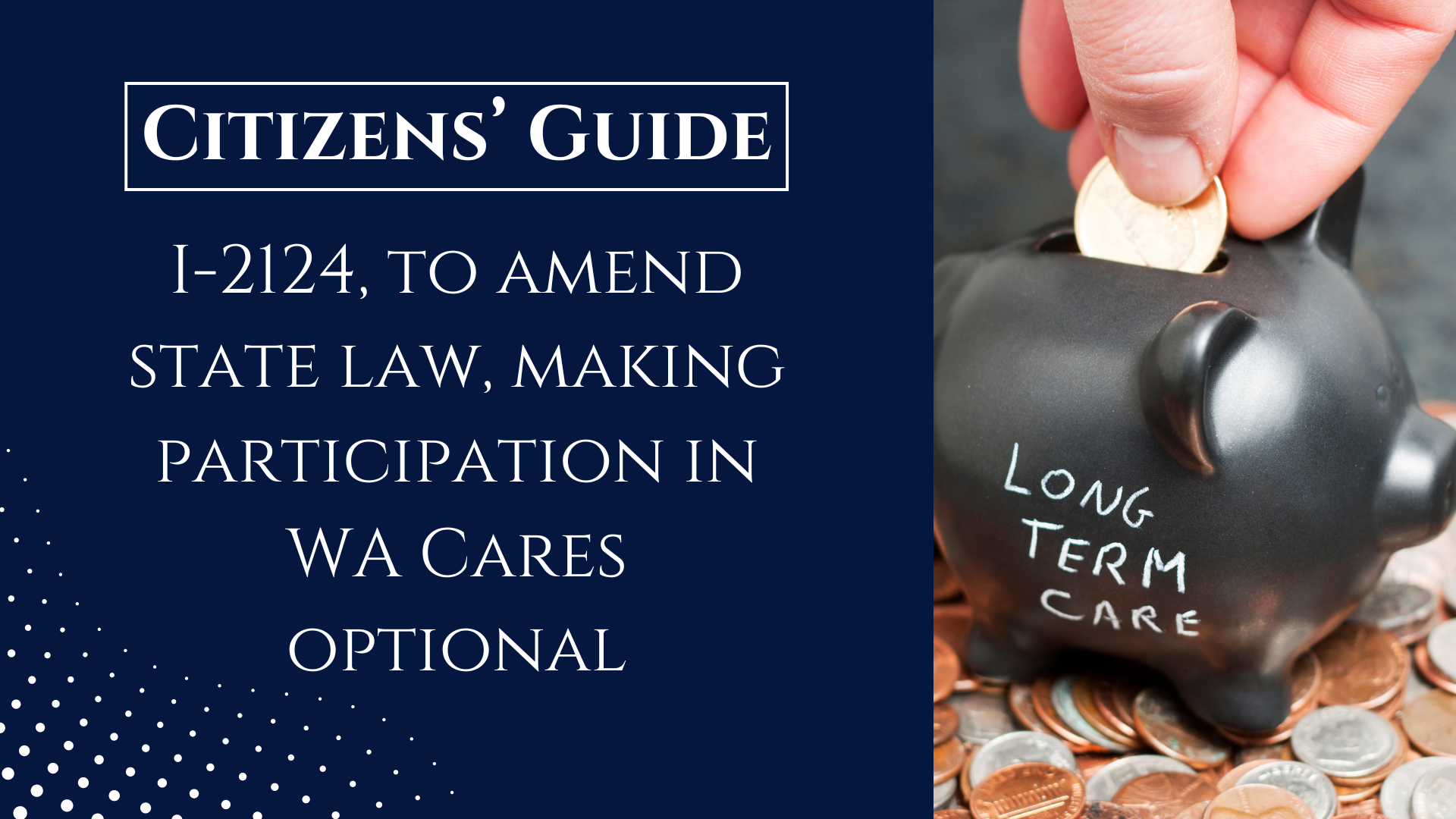Key Findings
- WA Cares is a state-imposed program that promises to help cover long-term care (LTC) for workers in Washington state, created in 2019 by House Bill (HB) 1087.
- The program is funded by a significant payroll tax of 58 cents on every $100 of income a Washington state worker earns, regardless of income level. It is mandatory for most W2 employees.
- A lifetime benefit of up to $36,500 could go to Washingtonians who pay into WA Cares, if they meet certain health criteria and if they have paid the payroll tax for a required number of years — typically 10 years without a break of five or more years.
- This lifetime benefit is not typically enough to cover a person’s LTC costs, should they need services.
- Even with its high payroll tax, WA Cares has solvency concerns.
- When the choice to opt out was temporarily available to those who had or obtained private long-term-care insurance (LTCI), nearly 500,000 workers left the program.
- Initiative 2124 would give all workers a choice about whether this program is right for their individual financial and possible health needs, making WA Cares a voluntary, rather than mandatory, program and protecting workers’ wages.
Introduction and background
In 2019, Washington state lawmakers passed, and the governor signed, HB 1087. It required the creation of a mandatory social program and the collection of another payroll tax from W2 workers, although only some workers would eventually benefit.
Tax collection for the program, called WA Cares, began in July 2023 after an 18-month delay. The delay was related to several factors, including nearly 500,000 workers leaving the program under a limited exemption, the temporary halting of private, long-term-care insurance sales in the state and legislative changes in the law due to its many shortcomings.
The payroll tax for WA Cares is not insignificant. It takes 58 cents from every $100 a worker earns, regardless of income or the number of hours he or she works. Some workers will never benefit from the fund. If an individual does meet certain health requirements and has paid the payroll tax for a required number of years, he or she is eligible to receive up to $36,500 that can go toward state-approved, long-term-care services. This amount is not typically enough to cover most people’s long-term-care costs and in many cases would only provide about three months of care.
WA Cares already has solvency problems. Early on, after voters said “no” to changes in how fund dollars could be invested, State Actuary Matt Smith told a reporter of the solvency problems, “Put another way, in today’s dollars, the program is expected to require an additional $15 billion of revenue to cover the next 75 years of benefits and expenses.”
An actuarial study in 2022 found that WA Cares would remain solvent at its current rate under some scenarios, but that under other scenarios it wouldn’t. Various factors could result in a need for a higher tax rate or lower benefit, including workers’ wages and employment numbers, use of the benefit, higher mortality improvement, lower fertility rates, investment income and if the benefit rises with inflation. Information reported on the WA Cares website confirms this conclusion.
In part because of solvency concerns, the state’s Long-Term Services and Supports (LTSS) Trust Commission continues recommending changes for WA Cares to lawmakers. The commission discusses potential problems with program solvency and has considered recommending stricter eligibility for Washington state workers. Another recommendation is to require people who opted out of WA Cares because they had LTCI to show they still have it. The commission has also discussed increasing the payroll tax for WA Cares to keep the fund solvent over time.
Even if the WA Cares Fund stays solvent or is made solvent by changing various eligibility terms or the tax rate , many workers will still never see a return on the taxes they are being forced to pay. This includes people who will never need long-term care and workers who don’t meet the state’s health care criterion. It also includes workers who do not meet difficult vestment eligibility. Workers must pay the payroll tax for 10 years without a break of five or more years and meet a required number of hours in each year of eligibility. This is especially hard on family caregivers, single parents and others who shift in and out of the formal workforce.
From the outset, the program bars some workers from ever receiving a WA Cares benefit, even though they pay the payroll tax. These workers include H2A and other workers on non-immigrant visas and Washington state workers who reside in another state. In addition to veterans with a 70% service-connected disability and some military spouses, these workers have been given the option to apply for voluntary exemptions. Some who know about their ability to do so have, adding to more solvency concerns. Workers who meet exemption criteria are not automatically exempted by the state. Like workers before them who opted out of WA Cares because they had private long-term-care insurance, they must seek their exemptions.
Benefits that will eventually go to some recipients will only be able to be used on services that have state approval. Rules are still being made. Not all services or caregivers a person chooses will be approved.
Even with no guarantee of a benefit or what exact services and caregivers will qualify, the state is telling Washingtonians to have “peace of mind” about long-term-care needs because the WA Cares program exists. The program has a strong marketing campaign in place. Being forced to pay into an unpopular program from which one may never benefit, however, does not contribute to “peace of mind.”
Lawmakers pursued this program to shift some of the state’s costs related to long-term-care payouts through Medicaid (also called Apple Health) onto workers. This state safety net’s burden is growing, along with the state’s graying population. Policies continue to allow middle- and upper-class people to take advantage of taxpayer dollars that are meant for people in need.
Outcry from state residents did not stop WA Cares before the tax collection began in July 2023. Legislation filed to repeal the long-term-care law also went ignored, as did legislative efforts to make participation in WA Cares optional.
→ Download the full Citizens' Guide←






